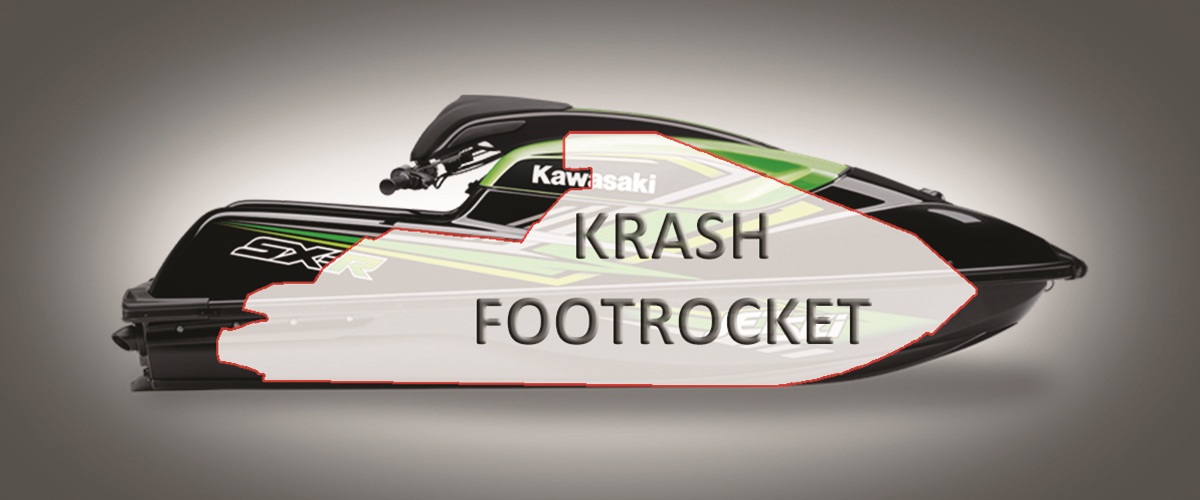
Kawasaki SX-R 1500 vs. SuperJet vs. Krash Comparison
Over the years, many manufacturers like Honda, Polaris, Artic Cat (Tigershark) appeared and disappeared, but none of them came close to Kawasaki which still remains one of the top and most well-known brands on the PWC market.
However, Kawasaki is not the only manufacturer who offers stand-up watercrafts, the main competitors of the Kawasaki SX-R 1500 are the Yamaha Superjet and Krash Watercrafts. Another one of the leading PWC manufacturers, Sea-Doo, does not currently manufacture stand-up models.
Here at JetDrift, we have compiled all the facts and figures about these watercrafts so you can thoroughly compare these current models by their specifications and prices.
First, let’s take a look at their history; how it all began.
The history of stand up Jet Ski
Everything started in 1972 with the introduction of Kawasaki’s first stand-up Jet Ski. The first models (WSAA and WSAB) were powered with 2 stroke, 400 cc twin cylinder engines.The original brand names of these first Kawasaki watercrafts were “Water Jet” and “Power Skis” before being changed into “Jet Ski”.
It should be noted, however, that even though this term is genericized and used for watercrafts in general by the public, it is in fact a registered trademark of Kawasaki and cannot be affiliated with any other brand. That is why you can never find a “Yamaha Jet Ski“, a “Sea-Doo Jet Ski” or a “Honda Jet Ski” on the market.
Shortly after the release of their first stand-up jet ski, Kawasaki became the market leader in the PWC industry for around 16 years. They improved their Jet Skis continuously and added new and improved models into their line up. These included the iconic models like the 550SX from 1990, and the extremely popular SX-R 800 from 2003.
In 2107, Kawasaki released the first 4 stoke stand up Jet Ski, the SX-R (SX-R 1500). With this, Kawasaki made a comeback into the market of stand-up watercrafts, which it had always been famous for.
Is the stand up Jet Ski for you?
Stand-ups are still really popular among PWC enthusiasts, as they offer an engaging and palyful riding experience. But before we go any further, it’s worth a shot to think about whether a stand up PWC is a perfect choice for you or not.Beyond the unique riding style, a stand up jet ski has several advantages.
They are the most lightweight models available in the market which enables you to launch, store and move them more easily. Moreover, Stand up Jet Ski trailer weights are also usually lower compared to the other watercraft trailers.
Their purchase prices and maintenance costs are much lower than most of the “sit down” type watercrafts and their services are also easier as they are simpler machines with minimal features.
In every stand up model, you can find a naturally aspirated engine, which there is no supercharger in them. Supercharged engines carry a bigger chance of failure, and repairs could be highly expensive.
A stand up watercraft also does not have any display, brake or reverse system, nor does it have any speakers or any other bells or whistles that might be prone to failure.
While there are several reasons for you to choose a stand up watercraft, there are certain drawbacks associated with it too.
The first and most important disadvantage of a stand up PWC is that you cannot take any passengers with you. This means that you can only expect solo rides on them making these models not so family friendly.
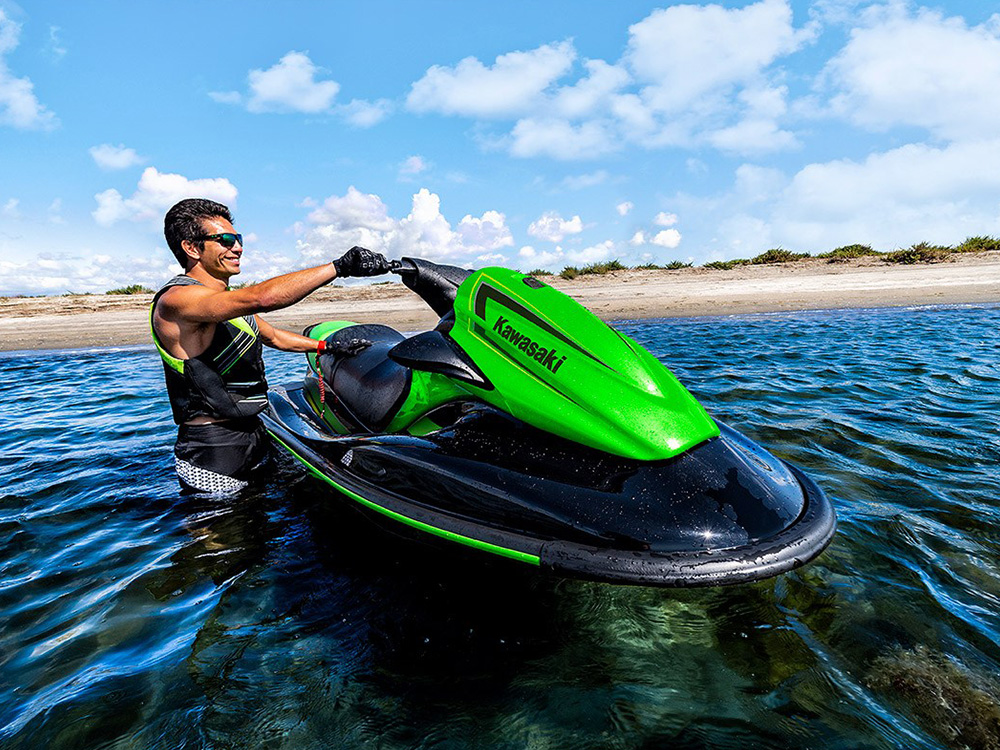 Moreover, you can’t use stand-ups to tow any tube or wakeboard or even go for a jet ski fishing trip.Furthermore, riding a stand-up watercraft requires a certain level of athletic skills and prior experience making them not suitable for everybody. Additionally, you can also easily expect a longer intended learning period on them.
Moreover, you can’t use stand-ups to tow any tube or wakeboard or even go for a jet ski fishing trip.Furthermore, riding a stand-up watercraft requires a certain level of athletic skills and prior experience making them not suitable for everybody. Additionally, you can also easily expect a longer intended learning period on them.
It is also good to know that there are just a few stand up PWCs on the market for you to choose from whereas you have a variety of different watercrafts available to you when you’re looking for a sit-down model.
Many riders appreciate the extreme top speeds and accelerations of the performance models, while they still remain dry. The sit-down models can also carry many gears and are much more stable even on the rough water.
In conclusion, it would be hard to compare these two main categories with each other because both types of watercraft serve a specific purpose. Their riding style and many other features are completely different.
It would be like comparing a dirt bike to a street bike; both of them are great but on their own territory!
Before you make your final decision on purchase, beyond purchase prices, make sure you’ve taken count all possible maintenance costs, storage and servicing issues.Following these links below, you can also compare all currently available models by their performance, top speeds or gas consumption numbers.
If you are interested in, don’t hesitate to discover more!
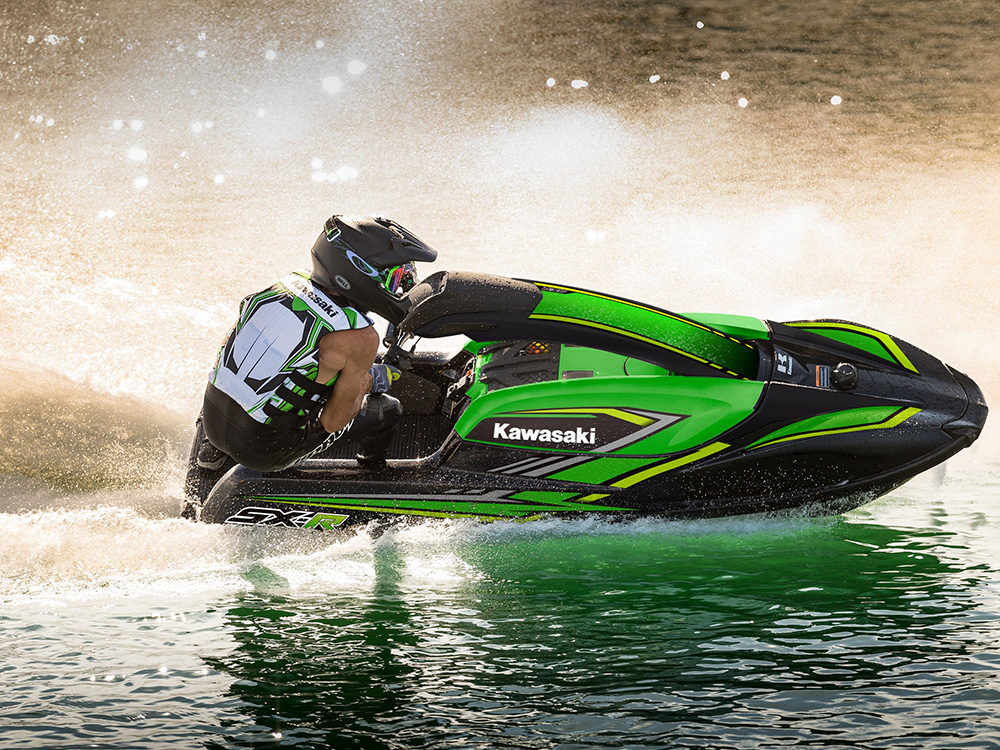
2020 Kawasaki SX-R 1500 Price Tag
You can compare the current stand up Jet Ski price tag with the competitors’ in this chart below.If you would like to discover more about these models, just click on the name of the models. Everything including specs, videos, pictures, and head by head comparisons is available through the links.
| Brand | Model | Price (USD) |
|---|---|---|
| Yamaha | SuperJet | $8 699 |
| Kawasaki | SX-R | $9 999 |
| Krash | 50 CAL | $12 599 |
| Krash | Reaper | $12 599 |
| Krash | Predator | $12 599 |
| Krash | FootRocket | $12 599 |
| Krash | Footrocket Pro | $16 799 |
The 2020 Kawasaki SX-R (1500) price is still pretty reasonable at $9.999 while the prices of Krash models start from $12.599, and go up to $16.799.
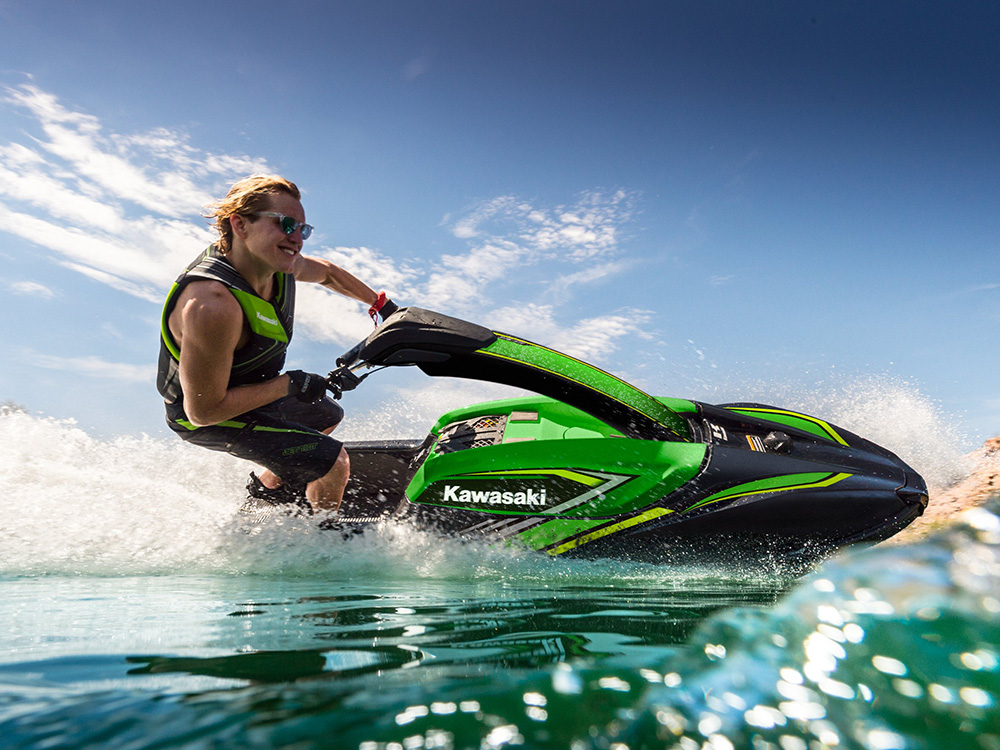
Kawasaki SX-R 1500 Top Speed vs. Competitors
When it comes to top speed and other performance specifications, the numbers attract the most attention of many performance-minded PWC buyers.The speed factor is maybe even more important in case of stand ups, as they are primarily used for sport and racing purposes. You can’t expect light recreation sunset cruises with these crafts!
Beyond the Kawasaki SX-R 1500 top speed and performance numbers, you can find the same specifications from the competitor models here:
| Brand | Model | HP | Top speed (Mph) | Power to weight ratio |
|---|---|---|---|---|
| Yamaha | Superjet | 73 | 45 | 0,24 |
| Kawasaki | SX-R | 160 | 62 | 0,29 |
| Krash | 50 CAL | 130 | 46 | 0,42 |
| Krash | Reaper | 130 | 46 | 0,40 |
| Krash | Predator | 130 | 46 | 0,43 |
| Krash | Footrocket | 130 | 46 | 0,42 |
| Krash | Footrocket Pro | 130 | 46 | 0,48 |
All of these engines are naturally aspirated (non-supercharged) and cooled with an open loop cooling system.
| Brand | Model | HP | ccm | Cylin- ders | 2T / 4T |
|---|---|---|---|---|---|
| Yamaha | Superjet | 73 | 701 | 2 | 2 |
| Kawasaki | SX-R | 160 | 1498 | 4 | 4 |
| Krash | 50 CAL | 130 | 997 | 2 | 2 |
| Krash | Reaper | 130 | 997 | 2 | 2 |
| Krash | Predator | 130 | 997 | 2 | 2 |
| Krash | Footrocket | 130 | 997 | 2 | 2 |
| Krash | Footrocket Pro | 130 | 997 | 2 | 2 |
You can find the same engine in the STX-15F, which is a really cheap Jet Ski from Kawasaki.With this powerful engine, you can expect the Kawasaki SX-R (1500) top speed to be around 60-62 mph which is beyond outstanding in the stand-up category. However, this model has a heavier and larger hull as well which restricts the ease of playful activity in the water.
The power to weight ratio is something we have to mention when talking about performance specifications. The SX-R’s weight is significantly higher when compared to its competitors, yet its power to weight ratio is still 0.29. (160 HP/ 551 lbs curb weight).The competitor, the Yamaha Superjet (also known as Yamaha stand up jet ski, incorrectly), arrives with a 73 HP, 701 cc, 2 cylinders, 2 stroke engine. You can reach a top speed of around 45 mph on this model, and the power to weight ratio is 0.22. (73 HP/ 336 lbs curb weight).
If you are interested in the Krash watercrafts as well, they all arrive with the same 997 ccm, 2 cylinder, 2 stroke engines. These units generate around 130 HP and have outstanding 0.38 – 0.43 power to weight ratios. (103HP / 350-303 lbs curb weights). The expected top speeds go up to around 46 mph.
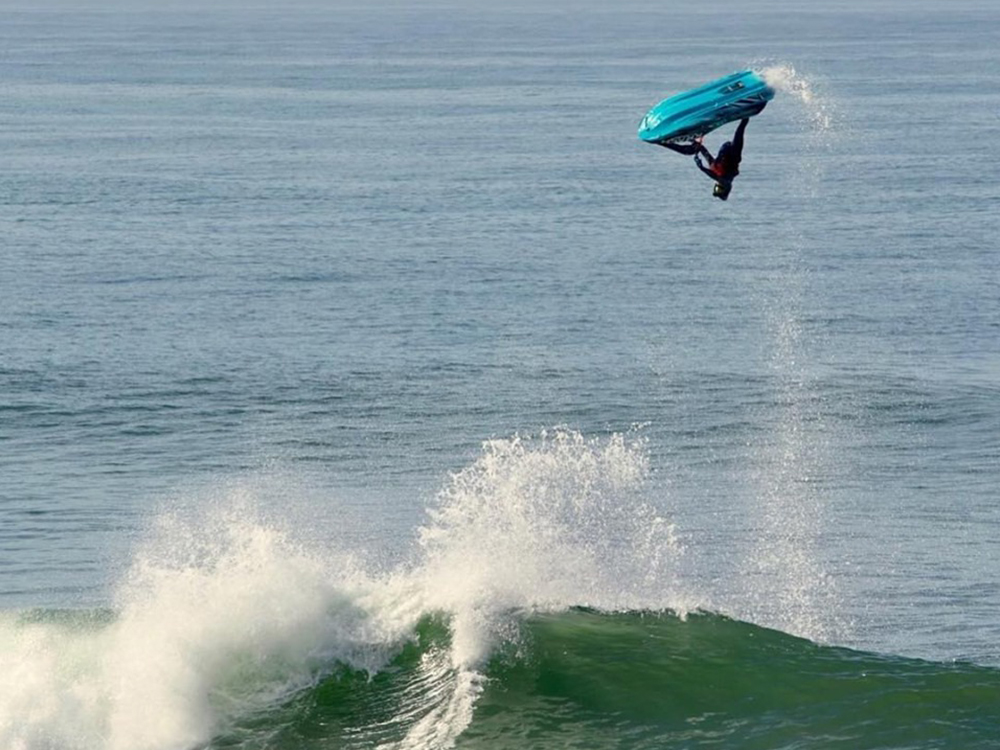
Kawasaki SX-R 1500 Dimensions
In the below section, you can discover the newest 2019 Kawasaki SX-R 1500 dimensions and also compare this model to its competitors visually and by the facts and figures as well. Before we move on, let’s take a look at how the stand up Jet Ski dimensions have changed over the years.
The first comparison we’re making is between the 550SX from 1990 and the SX-R 1500 from 2019: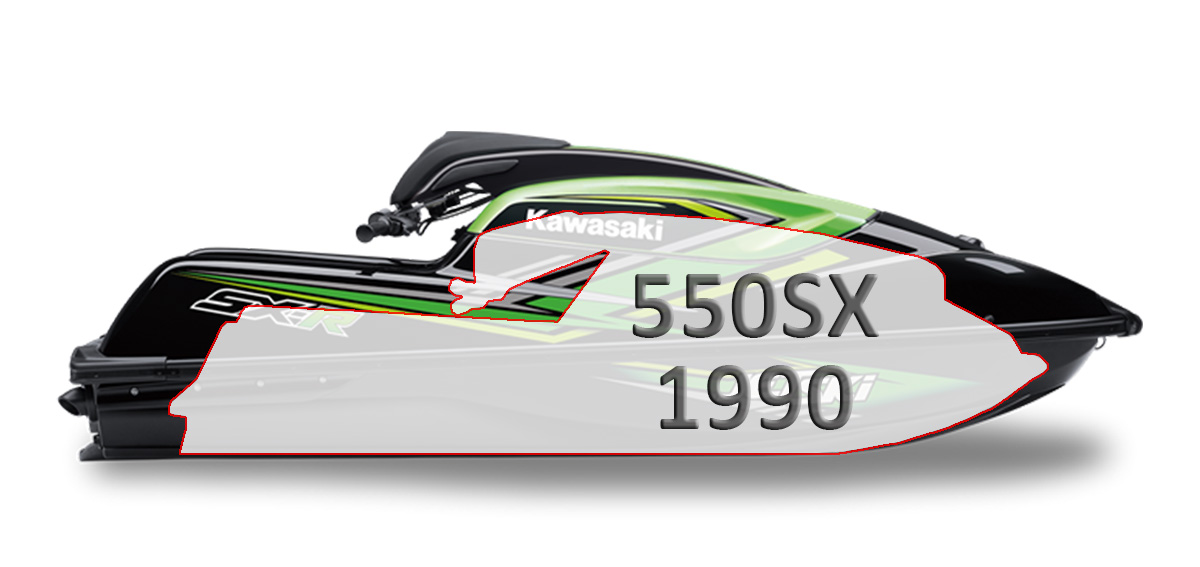 By just looking at the picture, we can say that the difference is huge. The length of the watercraft increased from 84″ to 105″ while the net weight has also increased from 251 pounds to 503 pounds; more than double the original size.
By just looking at the picture, we can say that the difference is huge. The length of the watercraft increased from 84″ to 105″ while the net weight has also increased from 251 pounds to 503 pounds; more than double the original size.
However, 1990 was a pretty long time ago, so let’s make a similar comparison with the SX-R 800 released in 2003, the forerunner of the current SX-R (1500) model: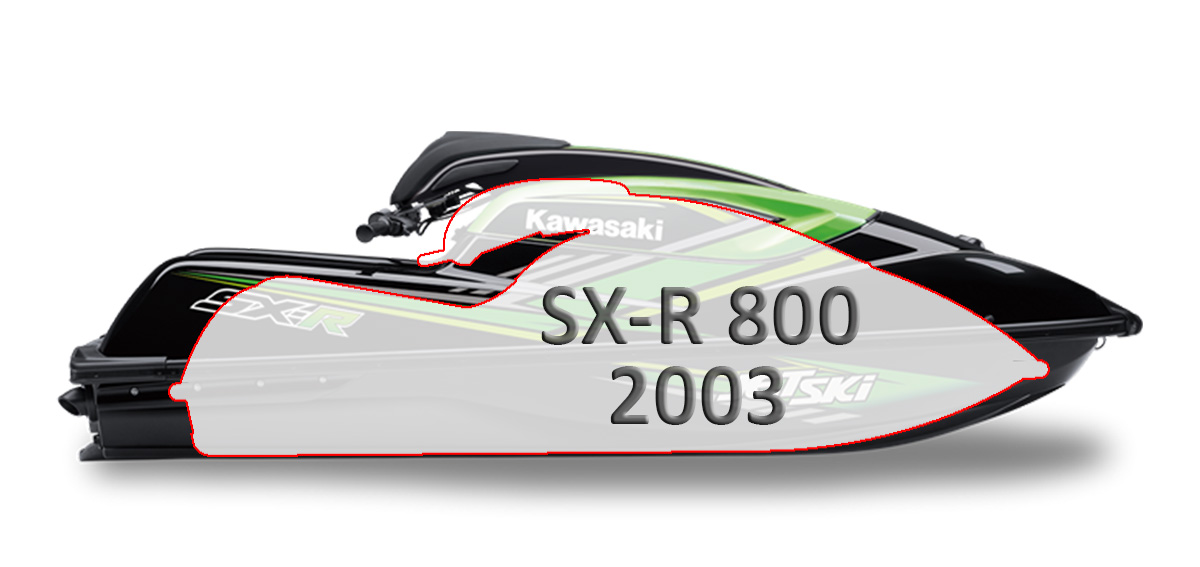 While the SX-R 800 is just 6.5″ longer than the 550SX, the difference in dimensions as compared to the new SX-R (1500) is still quite significant. To make this picture more clear, we’ve summarized the three iconic Kawasaki stand up jet ski specifications in this chart below:
While the SX-R 800 is just 6.5″ longer than the 550SX, the difference in dimensions as compared to the new SX-R (1500) is still quite significant. To make this picture more clear, we’ve summarized the three iconic Kawasaki stand up jet ski specifications in this chart below:
| Year | Model | HP | Weight (Lbs) | Length (") | With (") |
|---|---|---|---|---|---|
| 2019 | SX-R | 160 | 551 | 105 | 30 |
| 2003 | SX-R 800 | 80 | 351 | 89,8 | 29,6 |
| 1990 | 550SX | 41 | 251 | 84 | 24 |
Kawasaki SX-R vs. Yamaha SuperJet vs. Krash Comparison
After this short historical summary, let’s compare the current SX-R 1500 Jet Ski to the competitor models from Yamaha and Krash Industries. This chart below contains each model’s dimension and weight specifications:| Brand | Model | length (") | width (") | net weight (Lbs) | curb weight (Lbs) |
|---|---|---|---|---|---|
| Yam. | Superjet | 88.2 | 26.8 | 306 | 336 |
| Kaw. | SX-R | 104.5 | 30.1 | 503 | 551 |
| Krash | 50 CAL | 82 | 30.5 | 308 | 338 |
| Krash | Reaper | 88 | 32 | 321 | 351 |
| Krash | Predator | 84 | 28 | 304 | 334 |
| Krash | Foot rocket | 82 | 26 | 308 | 338 |
| Krash | Foot rocket Pro | 82 | 26 | 273 | 303 |
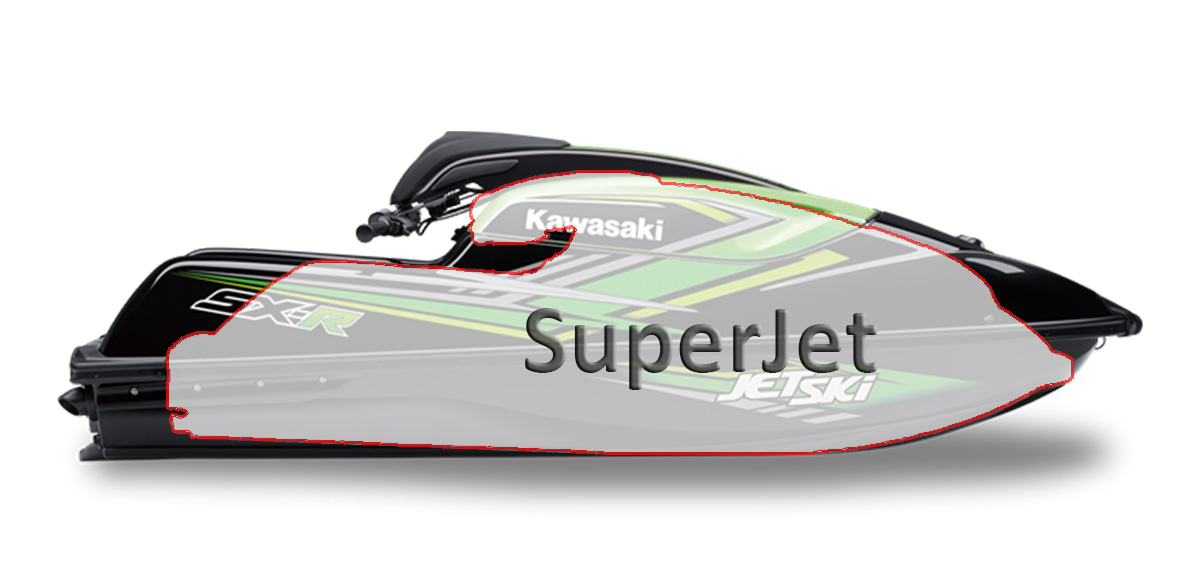 If we compare the hull dimensions, we can see that the SX-R (1500) is significantly longer with its hull’s length around 104.5″, while the Superjet is 16″ shorter. As far as the weights are concerned, the Kawasaki’s net weight is around 503 pounds against the Yamaha’s 303 pounds. The difference is significant again!
If we compare the hull dimensions, we can see that the SX-R (1500) is significantly longer with its hull’s length around 104.5″, while the Superjet is 16″ shorter. As far as the weights are concerned, the Kawasaki’s net weight is around 503 pounds against the Yamaha’s 303 pounds. The difference is significant again!
Moving on, we can have the same comparison between the Krash Footrocket Pro and the Kawasaki SX-R 1500: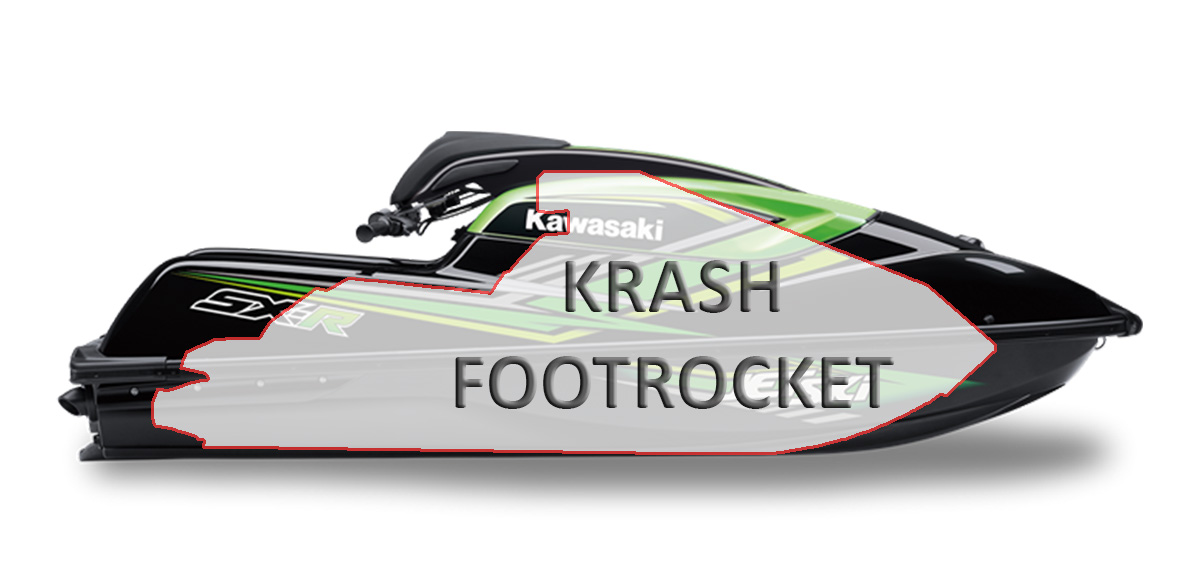 The lengths of the Krash’s models are between 82″ – 88″, while the Footrocket arrives with one of the shortest hulls; only 82″.
The lengths of the Krash’s models are between 82″ – 88″, while the Footrocket arrives with one of the shortest hulls; only 82″.
Comparing this to the SX-R 1500 hull which is 104.5″ long would be unfair. The Kawasaki is 27% longer!
However, to our surprise, the Footrocket Pro’s net weight is less than the Superjet’s, 303 pounds. We have to mention here that this is the “Pro” version of the Krash Footrocket that has a net weight of only 273 pounds giving us a more extreme power to weight ratio. There is an another version of Footrocket, with 308 lbs net weight.
Based on the comparisons above, you may be interested in how these models look when put side by side.
For even better presentation, we at JetDrift have also created this summary picture for you: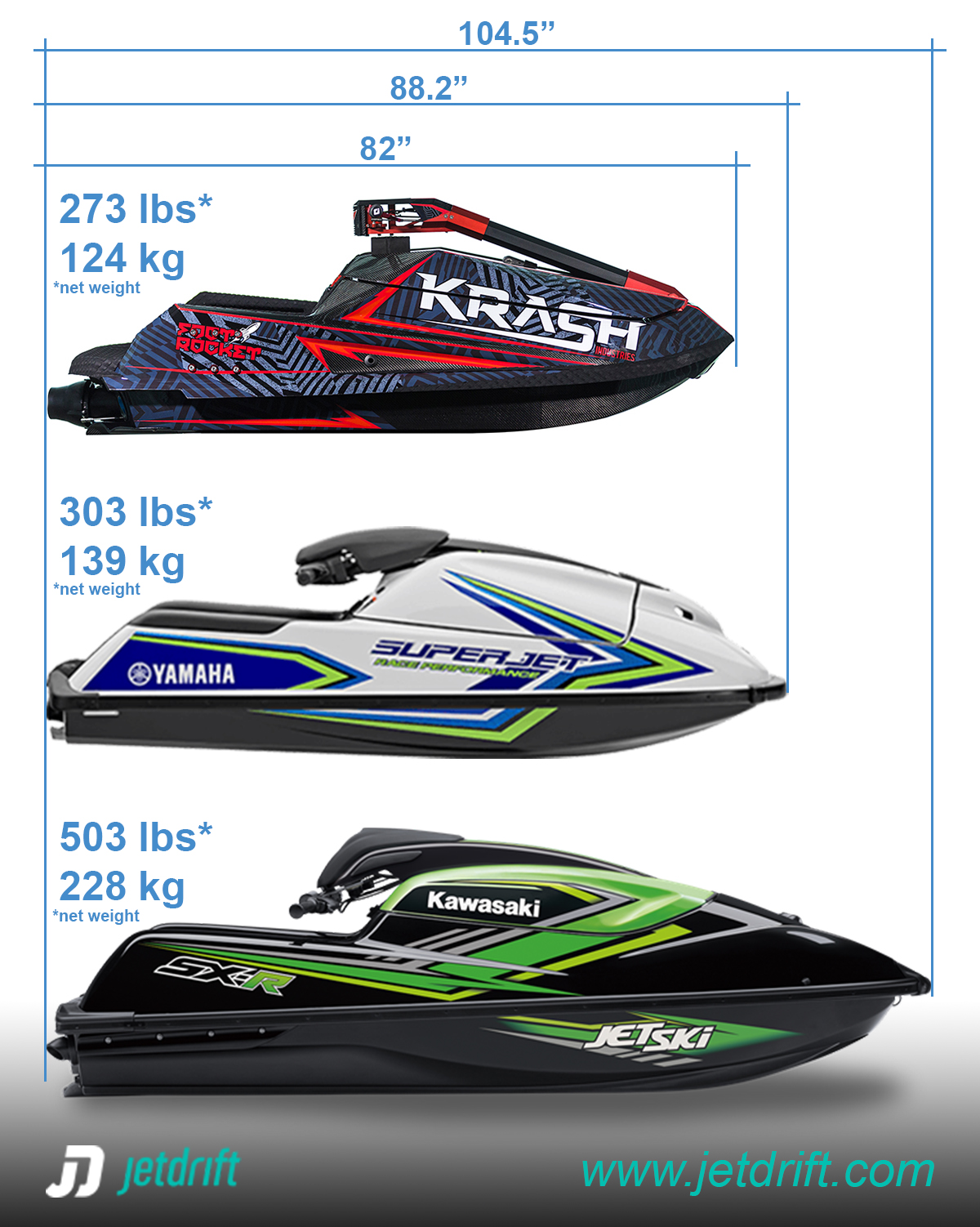 As you can see, the Krash models and the SuperJet come with near the same net weight, around 300 pounds, while the stand up Jet Ski net weight is 503 pounds, while the curb weight is 551 puonds.
As you can see, the Krash models and the SuperJet come with near the same net weight, around 300 pounds, while the stand up Jet Ski net weight is 503 pounds, while the curb weight is 551 puonds.
The difference in weight comes from the 2019 SX-R (1500) Jet Ski’s bigger hull and the weight of its four-stroke engine. Understandably, the difference in the engines and fuel capacities affects the curb weights.
The SuperJet and Krash models’ fuel capacity is 4.8 gallons while the stand up Jet Ski gas tank size is 6.1 gal. Let it not be forgotten that it does have a 4 stroke engine, so we have to add the weight of the oil (1.3 gallons) to get an accurate measure of the curb weight.
Kawasaki SX-R 1500 For Sale
Considering all of the above information, if you’ve made the decision to purchase a stand-up watercraft for yourself, it is now time to find the perfect place for you to purchase one.The good news is that there are several good Kawasaki Jet Ski dealerships all over the county that can help you in your search for the perfect model.
If you prefer a used one, you can find many second-hand Kawasaki SX-Rs for sale at Craigslist, Ebay, or at PWCTrader. You can also find Krash watercrafts and SuperJets on these sites as well. If you are looking for a new SuperJet, you can also purchase one from your closest WaveRunner dealerships.However, before you purchase a watercraft, make sure to take it for a test ride.
Dealerships usually offer special demo days for this purpose. On the other hand, if you are just looking for some seasonal fun in the water, you can always rent out a watercraft from the various local watercraft rentals!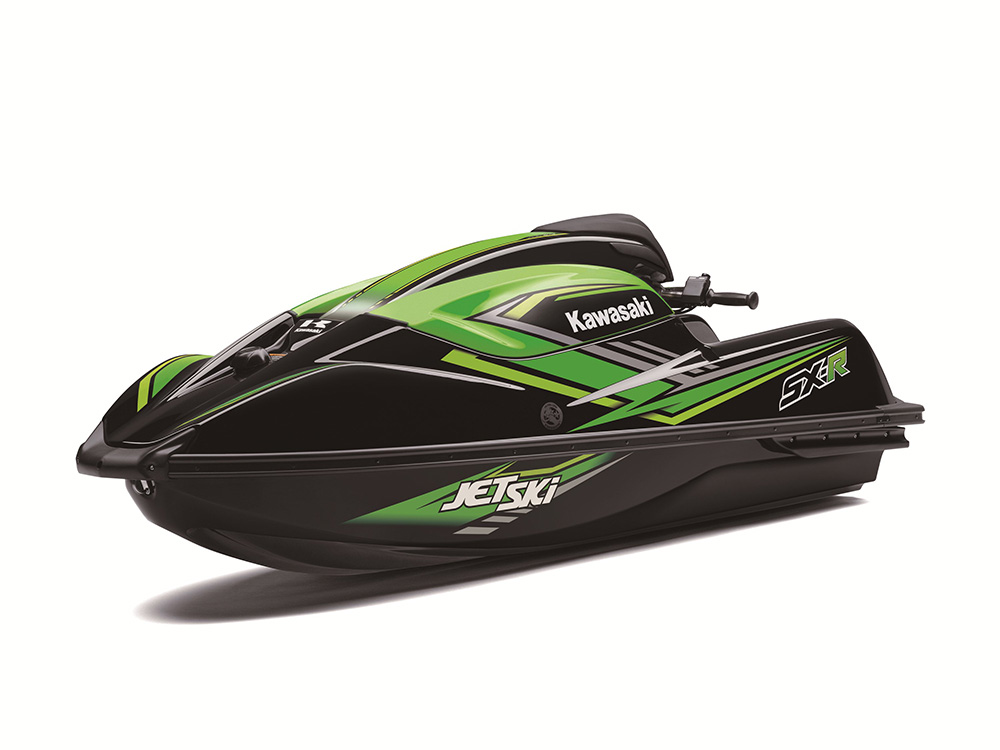
Stand Up PWC Tricks and Skills
Kawasaki SX-R 1500
With the benefits of its weight and large hull, you will find riding on the Kawasaki SX-R 1500 really stable and smooth. The starts will be much easier and the hull is large enough to keep you onboard.
This means that it won’t sink or overturn during the starts. You will really enjoy this ability especially if you are a beginner.
Even beyond the starts, if you want to ride a stand up at around 60-62 mph and take fast turns at the same time, this Jet Ski remains stable in any situation.
You can see how smooth the starts are with the SX-R 1500 on this video:
On the other hand, the weight and big hull of this watercraft does not offer the same playful rides like on the older stand up jet skis. It means you can’t perform as many tricks and sharp turns as you would like to. You get more stability but much less nimbleness.Overall, it runs really fast, is extremely powerful but it’s definitely not a freestyle stand up jet ski!
Yamaha SuperJet
The SuperJet is significantly smaller and lighter as compared to its competitor, the SX-R 1500. This model is much more agile and promises a fun and playful riding experience with sharper turns. It’s also really nimble and gives you quick response.
On the other hand, the SuperJet is definitely less stable, especially at higher speeds. So it means more restarts with this craft for you, and the learning period may also be extended and require a great amount of commitment and effort.
However, once you are an experienced rider and have got the hang of it, you can do many good tricks with a SuperJet:
There are widespread rumors about the fact that the SuperJet is only available for racing purposes due to the US EPA restrictions. Fortunately, according to WatercraftJournal, this is just false gossip and you can conveniently purchase and use one.You just need to get a competition card from IJSBA (International Jet Sport Boating Association) through the official IJSBA website or from your dealership.
Krash freestyle PWCs
The Krash watercrafts are even smaller and lighter which means these crafts are extremely nimble and not easy to ride.
You will need a bunch of athletic skills and experience to ride them well. But once you master this watercraft, you can perform amazing tricks with it. But beware, it’s definitely not for beginners!
This was our short Kawasaki SX-R 1500 vs. Yamaha SuperJet vs. Krash comparison, we hope you find it useful!![Kawasaki SX-R 800 Specs and Review [Video]](https://www.jetdrift.com/wp-content/uploads/2020/06/Jet-ski-comparison-SX-R800-SX-R-1500-1-300x142.jpg)
![What is a Stand Up Jet Ski Called? Are They Still Being Made? [Video]](https://www.jetdrift.com/wp-content/uploads/2020/06/are-stand-up-jet-skis-still-made-300x125.jpg)
![Is it Hard to Ride a Stand Up Jet Ski? [Riding Guide]](https://www.jetdrift.com/wp-content/uploads/2020/06/how-to-ride-a-stand-up-jet-ski-300x125.jpg)
![1994-1995 Yamaha FX-1 Review and Specs [Video] yamaha fx1 review and specs](https://www.jetdrift.com/wp-content/uploads/2021/10/yamaha-fx1-review-and-specs-300x125.jpg)
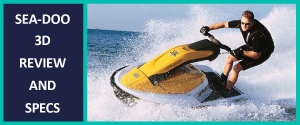
![Hydrospace S4 Specs and Review [Video] hydrospace s4 review](https://www.jetdrift.com/wp-content/uploads/2021/12/hydrospace-s4-review-300x125.jpg)